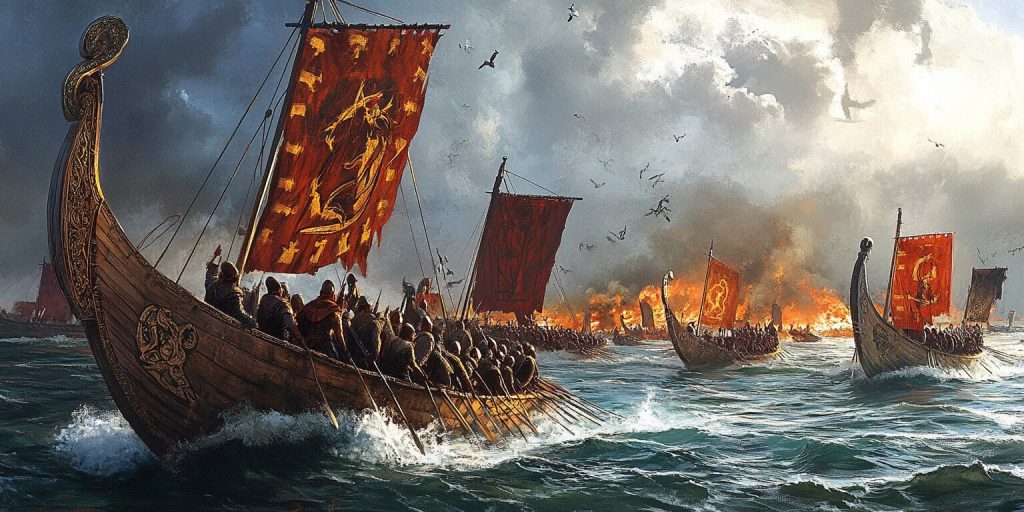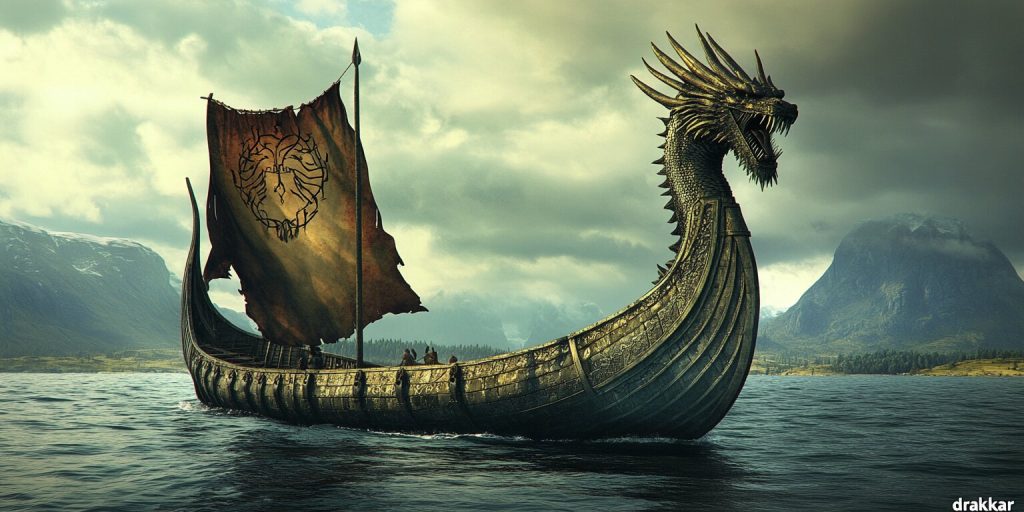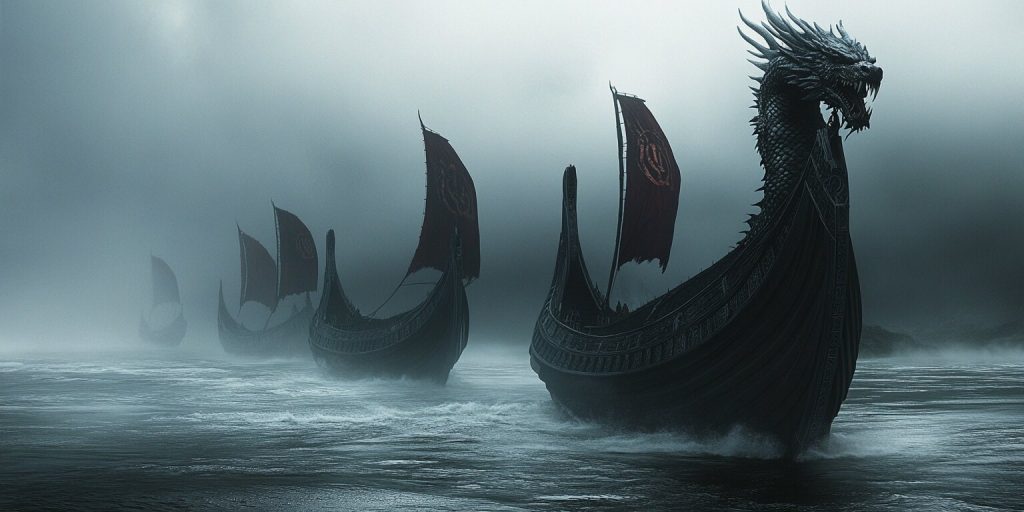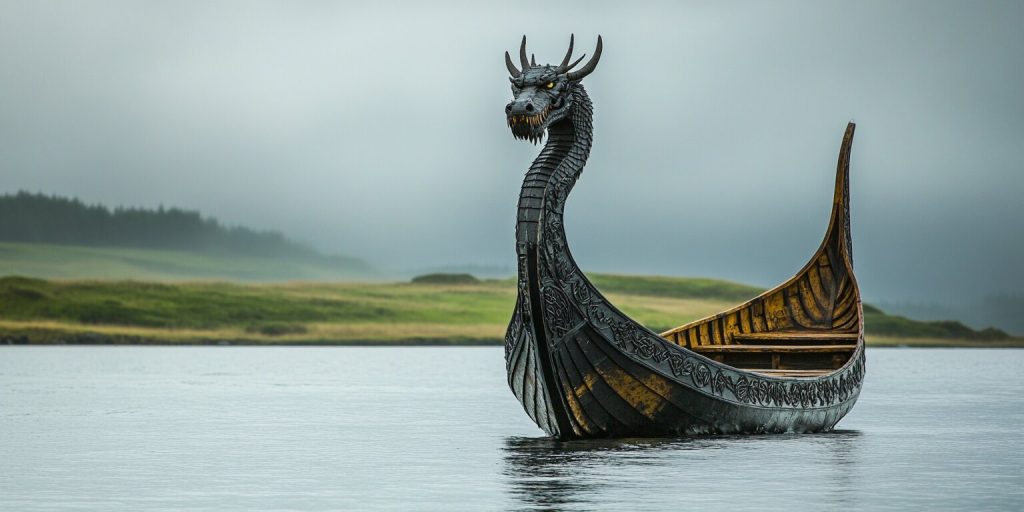Viking Ships, Vikings
What Does Drakkar Mean in Vikings?
The term “drakkar” refers to a special Viking ship with a dragon head at the front. In Norse, “drakkar” means “dragon.” This shows how important these ships were to the Vikings. They were more than just boats; they were marvels of naval engineering.
These ships let the Vikings travel long distances across Europe and even to North America. Learning about the Drakkar Norse helps us understand the Vikings’ seafaring skills. It also gives us a peek into their mythology and culture, often reflected in the ship’s prow designs.
Introduction to Drakkar in Viking Lore
The viking Drakkar is more than just a ship. It’s a symbol of adventure and exploration in Viking lore. These vessels were key for warriors and raiders, showing the Vikings’ spirit as they sailed through rough seas and quiet rivers.
The Drakkar could move smoothly on different waters. This made it vital for Viking raids. It helped them travel, explore new lands, trade, and fight, utilizing the strength of their viking boats.
Old stories like The Prose Edda and The Saga of the Greenlanders tell us about the importance of the Drakkar. They show how these ships were more than just moving people and goods. They were a symbol of the Viking warrior spirit and their deep mythology.
Learning about the Drakkar helps us see its big impact on Viking life and its mark on maritime history, especially in how they utilized oars.
Definition and Origin of Drakkar
The term drakkar refers to the iconic longships used by the Vikings, known for their impressive length of the ship. These ships were key to their maritime adventures. The word “drakkar” comes from the Old Norse “dreki,” meaning dragon. This shows how these ships were seen as powerful and fierce.
Drakkar started in the Viking Age when the sea was vital for trade, war, and discovery. Over time, the design and building of these ships changed. They were made to travel in both deep and shallow waters, which was key for Viking raids and explorations.
Learning about Drakkar helps us understand the Viking language and its clever ship designs. It shows how these ships helped the Vikings travel across Northern Europe and beyond.
The Significance of Drakkar Viking Ships
The Drakkar Viking ship is key to understanding Viking culture and their sea travels, particularly through the use of warships. These ships were more than just for moving people around. They were crucial for Viking raids, which changed Northern Europe’s history, especially using their warships.
Role in Viking Raids

Drakkar’s design allowed it to move fast in the sea and shallow waters, which was key to the success of Viking raids. It allowed warriors to surprise attacks on settlements.
Being able to go up rivers helped them get deep into enemy lands, showcasing the versatility of the bow and stern. The Drakkar’s speed and agility made it a scary sight in the Viking Age, much like a Viking longship. Raiders could attack fast and get away before enemies could react.
Cultural Symbolism of the Drakkar
The Drakkar is more than just a ship. It symbolizes the Viking spirit of exploring and conquering, bravery, adventure, and independence that defined the Vikings.
Its fancy figureheads and craftsmanship show the Norse people’s art and values, particularly in the design of the side of the ship. The Drakkar is a lasting symbol of their rich heritage.
Design Features of a Drakkar Viking Ship
The Drakkar was a top example of Viking ship design. It had unique features in its structure and look. Builders used new techniques that made the ship fast and strong. The design was both useful and beautiful, helping it sail long distances.
Construction Techniques Used
Building a Drakkar was a complex task. Builders used a method called riveting wooden planks together in a special way. This made the ship strong and flexible, perfect for rough seas. It also made the ship lighter, which helped it move faster.
This skill showed the Vikings’ cleverness in making ships. Their ships were well-equipped to handle tough journeys and raids.
Key Components of the Drakkar

A Drakkar had important parts that made it work well and give it an edge. Key parts include:
- Keel: This was the ship’s main support, helping it stay stable and navigate well.
- Mast: It held the sails, making the ship move quickly.
- Dragon Head Figurehead: This was a special feature that showed the ship’s power and strength, akin to the design of a warship.
These parts showed the Vikings’ need for practicality and their love for beauty. Each part was carefully made, making the Drakkar fast and beautiful, with oars that enhanced their speed.
Drakkar vs. Other Types of Viking Ships
The Vikings had many ship types, each designed for different purposes. Knowing about Drakkar, longships, and knarred helps us understand their culture, trade, and battles.
Comparison with Longships
Longships are known for their speed and agility. They were great for quick trips across the water. They were not as fancy as Drakkar but were made for fast travel, similar to a longship.
They could travel on rivers and seas. Their shallow draft made it easy to land on beaches during raids, a tactical advantage of Viking boats. This provided quick access to the side of the ship, making them perfect for Viking raids.
Differences from Knarrs
The Knarr was very different from the Drakkar. It was a cargo ship for trade, often constructed as a wooden ship. Drakkars were made for fighting and moving fast, but knarrs were strong for carrying goods far.
This shows how versatile Viking shipbuilding was, utilizing durability techniques like amati and resin. Knowing about knarrs and drakkars helps us see the Vikings’ varied ways of trading, exploring, and conquering.
Historical Significance of Drakkars
Drakkars were key in the Viking Age. They changed warfare and trade, and these ships showed Viking power and skill at sea.
Drakkar’s Role During the Viking Age
Drakkars were vital in raids and conquests. They were fast and agile, perfect for open waters and rivers. This allowed Vikings to surprise coastal towns and grow their lands and power in Europe.
Impact on European Trade and Warfare
Drakkars also changed trade. They opened trade routes from Scandinavia to Europe and beyond. Goods like timber and textiles moved easily, helping Viking communities and sharing cultures. Drakkars made a big difference in trade and war during the Viking Age.
Famous Drakkar Viking Ships in History
Many famous Drakkar ships have caught the eye of historians and fans. These ships were more than just for moving people around. They were key to Viking trips that changed European history. Today, archaeological finds reveal their skill and power.

Notable Expeditions
In their drakkar ships, Vikings played a big role in setting up trade paths and raiding Europe. Some key trips include:
- Leif Erikson’s journey to North America was around the year 1000.
- Expeditions by Ragnar Lodbrok to the British Isles and France, as told in sagas.
- The 845 raids on Paris showed the power of Viking longships.
Archaeological Discoveries
Recent digs have uncovered Drakkar’s deep history. Important findings are:
- The Oseberg ship burial shows a well-preserved Drakkar in Norway.
- The Gokstad ship gives clues about building ships and society.
- Remains found along the Scandinavian coast, proving Viking navigation and trade.
The Artistic Features of Drakkars
Drakkars were more than just ships. They showed off the art and beliefs of the Viking Age. The ships had figureheads that looked like dragons or fierce creatures. These were meant to scare enemies and protect those on board, much like the intimidation factor of a drakkar viking boat.
Figureheads and Decoration
Drakkars had more than figureheads. They were covered in detailed carvings and paintings, which showed mythological scenes and symbols important to Norse culture. This mix of beauty and function made the ships stand out in history.
The Importance of Ship Models
Ship models, particularly the longship model, help keep the Viking shipbuilding tradition alive. They show us how Drakkar was made and what made them special. By looking at these models, we learn about the art and practicality of Viking ships.
These models are key in museums and studies. They help us understand Viking craftsmanship for years to come.
Modern Interpretations and Representations of Drakkar
The Drakkar has changed a lot from its old days to now. It’s a symbol of Viking heritage today. You can see it in art, books, and movies that talk about Viking history. These stories make people more interested in the Vikings.
Authors use the Drakkar in their stories to show its importance. This helps readers learn about Viking life and culture, especially how the Vikings used their ships. It’s a way to teach and entertain at the same time.
The Drakkar is still a symbol of adventure and exploration today. It has become an icon that shows the Viking spirit, much like the revered Viking longship. Through art and stories, we keep remembering the Drakkar’s role in Viking history. It’s a way to honor the Vikings for the future.

